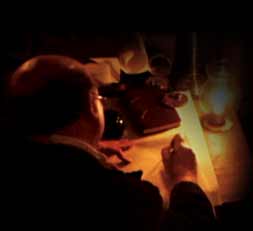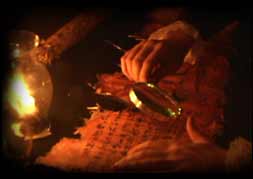The Abraham Story: An Introduction
By E. Douglas Clark
He has been called the most pivotal and strategic man in history. Jews, Christians, and Muslims — half the planet’s population — revere him not only as forefather but as an exemplary pattern of righteousness. Jewish tradition tells that his life was a pattern also of things to come, foreshadowing what would befall his posterity through the generations.
But his significance is nothing short of universal, for pursuant to the covenant God made with him, through him and his posterity would heaven’s blessings extend to all nations — by means of the Atonement and the latter-day restoration of the Gospel and establishment of Zion. For more than three decades I have sought to become acquainted with this remarkable man. His name is Abraham.
As a senior in high school I experienced a defining moment when I opened our monthly Church magazine (then called the Era) and began reading an article by Hugh Nibley. The subject was Abraham, and I am still at a loss to adequately explain what happened, except to say that I felt absolutely compelled to learn everything I could about him. The endeavor would be not my vocation but my avocation, one that would lead me to learn biblical Hebrew, participate in the annual meetings of the Society of Biblical Literature, interact with renowned scholars, travel to the Middle East to retrace Abraham’s route, and seek every source available from around the world that illuminated his life story.
Never has there been a story quite like his. Born in an idolatrous era of incredible cruelty and gross immorality, the boy somehow sensed that society had gone gravely amiss, and he began in earnest to seek the Creator. Reflection and prayer opened the heavens, but when he sought to persuade others to abandon their evil ways, he was mocked, persecuted, imprisoned, and ultimately placed on an altar to be sacrificed. Many years later he would endure the unfathomable irony of placing his own beloved son on an altar at God’s command.
Between those two memorable events came a host of trials and triumphs, prayers and promises, hardships and heavenly visitations. And with him every step of the way was his beloved Sarah. As capable as she was beautiful, she was actually his spiritual superior in important ways. But the decisive factor in their marriage and mission was a deep and undying love that kept them going and seemed to keep them young in spirit, even after they had grown old waiting for the fulfillment of God’s promise of posterity.
That it finally took miraculous means to achieve that promise seems to point ahead to another miraculous birth by another beautiful woman, whose child would come as Son of God and descendant of Abraham. Nor was the Savior the only descendant foreshadowed in Abraham’s long and eventful life. When 14-year-old Joseph Smith knelt to pray, it was a stunning reenactment of what his forefather Abraham had also done as a young boy at the very same age. Joseph’s prayer in fact opened the door for the latter-day fulfillment of Abraham’s covenant.
It is that covenant, along with the sterling example set by Abraham, which is his true legacy. If the great Egyptian pyramids built by the pretenders to Abraham’s priesthood authority were a wonder of the ancient world, it was Abraham himself who was the greater wonder — he who spent his life not amassing fortunes nor constructing massive self-serving monuments, as he easily could have done, but selflessly building the kingdom of God and establishing Zion, and thereby shedding the blessing of God as widely as possible. No wonder the Lord commanded his us to “Do the works of Abraham.”And no wonder modern prophets and apostles have reminded us to do so. In the words of President Spencer W. Kimball, “Now is the time to follow Abraham’s example.”
So where do we turn to read of Abraham’s example and learn of his works? The most widely known source telling of his life is of course the book of Genesis, where even the casual reader is struck by the sudden shift of emphasis at the end of chapter 11. As noted by German scholar Gerhard von Rad, “All at once and precipitously the universal field of vision narrows; world and humanity... are submerged, and all interest is concentrated upon a single man.” [2]
The story of salvation has suddenly become the story of this one man, Abraham, for in him and his posterity are all nations to be blessed. From that point forward the biblical account is the narrative of how that blessing unfolds, beginning with some twelve chapters showing us an unprecedented close-up of a biblical character — his life, conversations, revelations, travels, and even domestic doings. His wife Sarah is the first woman after Eve to be even named in the Bible, and gets far more press than any woman before her.
Even so, the Genesis account of Abraham and Sarah is at times so terse as to be, as Erich Auerbach describes, “fraught with background.” [3] Some passages can be downright perplexing, seemingly incongruent or nearly incomprehensible. For example, how is it that the steadfastly faithful Abraham, who had been willing to leave home and kindred at God’s command, suddenly seems to lapse into dismal faithlessness in Egypt by passing his wife off as his sister? Scholars note that he appears to be “acting completely out of character” [4] in this “puzzling” [5] and “incongruous scene” [6] that stands out as “a mélange of the credible and the unexplained.” [7]
Such incongruence in the Genesis text arises from the troubled transmission of the Hebrew bible over thousands of years, during which it “suffered from the shortcomings of man,” [8] including not only all kinds of scribal errors [9] but also, as respected scholar Michael Fishbane has shown, deliberate alterations and omissions. [10] In short, despite the wealth of information it preserves about Abraham, the book of Genesis can at times be unreliable and misleading.
But with the restoration of the Gospel came the hope that Latter-Day Saints would receive further information about their illustrious forefather. The Book of Mormon, published in 1830, foretold that the latter-day work among a branch of Abraham’s posterity would bring them “to the knowledge of their fathers” and the covenants God had made to them.
The most dramatic fulfillment of that promise came in the stunning restoration of an autobiographical Abraham account that fills in key gaps left by Genesis, including the fact that God commanded Abraham to ask Sarah to say she was Abraham’s sister. In March 1842 when Wilford Woodruff helped set the type for the publication of the first installment of the Book of Abraham, his journal entry that night marveled at the book’s “great and glorious” truths, “which are among the rich treasures that are revealed unto us in the last days.” [12]
The Book of Abraham remains one of our most important, if sadly underused, scriptural treasures, revealing precious truths about Abraham’s story and his deeds that remain a beacon for his descendants.

